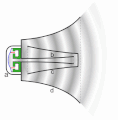Communauté • Livre d'or
 Actualités, astuces, interview... Venez lire la gazette de ce printemps de Vikidia !
Actualités, astuces, interview... Venez lire la gazette de ce printemps de Vikidia ! 
Fichier:Reflex loudspeaker animation 2.gif
Aller à la navigation
Aller à la recherche
Reflex_loudspeaker_animation_2.gif (392 × 400 pixels, taille du fichier : 96 kio, type MIME : image/gif, en boucle, 4 trames, 0,2 s)
Historique du fichier
Cliquer sur une date et heure pour voir le fichier tel qu'il était à ce moment-là.
| Date et heure | Vignette | Dimensions | Utilisateur | Commentaire | |
|---|---|---|---|---|---|
| Actuel | 3 mars 2013 à 03:51 |  | 392 × 400 (96 kio) | wikimediacommons>Chetvorno | User created page with UploadWizard |
Utilisation du fichier
Les 2 pages suivantes utilisent ce fichier :
